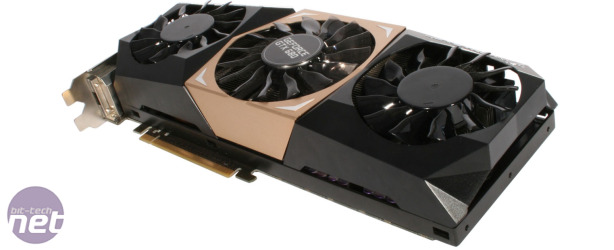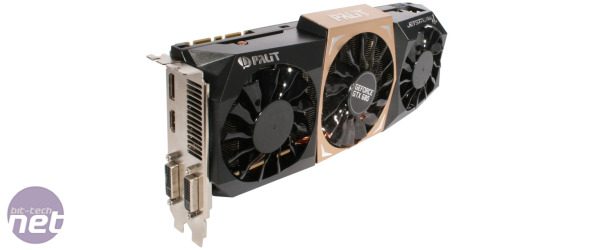Performance Analysis
Card inserted and drivers installed, the JetStream was ready to begin our battery of 3D tests. We started with our challenging Battlefield 3 play through. This proved to be a happy hunting ground for the JetStream as at 1,920 x 1,080 the card was a solid four frames per second quicker than a stock GTX 680 2GB and a mighty eight frames per second quicker than a HD 7970 GHz Edition. It maintained its lead in all our testing resolutions too, though it’s worth noting that it had slimmed down to a meagre one fps difference when using three screens via Nvidia Surround.Next up in our testing suite was Crysis 2. This is a new addition, and has replaced ARMA II as a recent update made ARMA much less reliable to benchmark with. The JetStream probably won’t thank us for the change however as it struggled to distinguish itself from the cheaper HD 7970 3GB in this game; the two cards had identical minimum frame rates at both our single screen test resolutions. It did pull out a lead at 5,760 x 1,080, though with a minimum frame rate of only 19fps, you’d need to drop some settings to make the game playable at this resolution.
Dirt 3 also proved to be a mixed bag for the JetStream. Unsurprisingly it outperformed a stock GTX 680 2GB in each of the tests, but for the latter two tests it was sandwiched between the stock HD 7970 3GB and the HD 7970 3GB GHz Edition. This is bad news, as pre-overclocked versions of the HD 7970 3GB that run at effectively the same speed as the GHz Edition can be had for around £50 less than the JetStream.
Our 3D testing ended with Skyrim, which is a strong point for Nvidia cards. This certainly proved to be the case for the JetStream as it bested the HD 7970 3GB GHz Edition by a whopping 19fps (24 per cent) at 1,920 x 1,080. The gap remained consistent at all our testing resolutions too, despite the larger amount of RAM on the red card.
3D testing over, we moved on to our thermal and power testing, and we were intrigued to see how the JetStream fared here, given the modified power draw and circuitry of the card. In truth, we were a little surprised to see that the JetStream only drew 6W (2.3 per cent) more than a stock card, even when at full load. Given that the JetStream was consistently performing between three and eight per cent better than a stock card, this seems like great value, and is also considerably less juice than an overclocked HD 7970 3GB would demand.
At this point then, the only potential deal breaker for the JetStream vs. a stock GTX 680 2GB is the cooler; it’s faster than a stock card, but if its cooler sounds like a bag of nails in a washing machine, we’re still not going to recommend it. It’s a pleasure, then, to say that the chunky cooler was very well behaved during testing, and though it does become audible during long gaming sessions, it’s definitely quieter than the reference model.
Overclocking
Given the improved VRM circuitry and big custom cooler, we were expecting the JetStream to enjoy overclocking. We weren’t disappointed either as we hit a base GPU frequency of 1,145MHz, an increase of 61MHz over the card's factory overclock. We were also able to up the memory by 100MHz effective to 6.4GHz.These are rather minor increases though, so didn't translate into huge gains in games; Battlefield 3 ran just one frame per second faster at 2,560 x 1,600.
Conclusion
Clearly we’re impressed with the price point that Palit has been able to hit with the GTX 680 2GB JetStream - at £400 it’s essentially exactly the same price as a stock card from a different manufacturer. This means that if you were looking at getting a GTX 680 2GB, the JetStream has become an almost de-facto choice thanks to its overclock and custom cooler. The only reason not to opt for it would be if the triple slot cooler was an issue in your build.Things are slightly less clear cut when you view the wider market however, as the JetStream didn’t comprehensively outperform the HD 7970 3GB GHz Edition. We’re well aware of course that this particular card is very hard to pick up, but it does provide a decent proxy for a factory overclocked HD 7970 3GB in our graphs, of which there are plenty around, many of which hit the 1050GHz boost clock speed of the GHz Edition. These cards can be had for around £360 - a significant chunk of cash less than the JetStream (and any other GTX 680 2GB for that matter).
What we’ll end by saying then, is that while we’re enamoured by the JetStream, we can’t recommend it unconditionally, unless of course you specifically want a top end card from the green side of the fence. For everyone else, it’s a tight call which will ultimately be decided by whether you think the superior efficiency, overclocking headroom and cooler of the JetStream is worth the £40 or so extra you’ll pay for it over a pre-overclocked HD 7970 3GB. If you've made up your mind to opt for a GTX 680 2GB though, then the JetStream is an easy choice.

-
Value25 / 30
-
Features27 / 30
-
Performance38 / 40


MSI MPG Velox 100R Chassis Review
October 14 2021 | 15:04











Want to comment? Please log in.